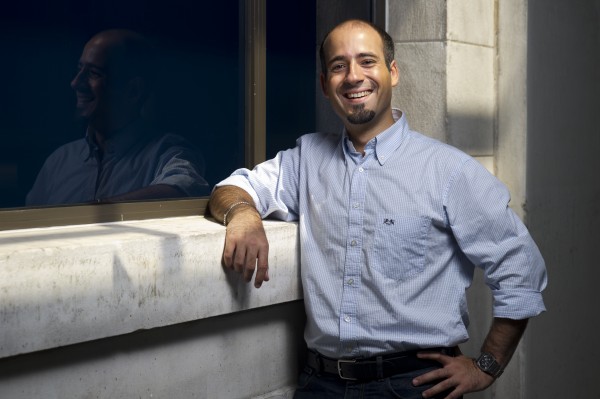Strumming on the nano-banjo

When you pluck a banjo string, you trigger a vibration that resonates at a frequency unique to the geometry and material of the string. We can distinguish that frequency as a particular pitch, our ears acting like incredibly sensitive detectors.
Matteo Rinaldi, an assistant professor of electrical and computer engineering at Northeastern University, has recently received a Young Faculty Award from the Defense Advanced Research Projects Agency to develop detection devices that work in a similar manner—but at a billionth of the size.
In the case of the banjo string, the mechanical energy needed to actuate the vibration comes from your finger. But in the case of Rinaldi’s tiny devices, the mechanism of action is bit more complicated: Electrical energy is employed to actuate vibration through a process called piezoelectric transduction.
Rinaldi’s devices resemble two overlapped ultra-thin sheets of paper stapled at either end. The top sheet absorbs energy in the form of infrared (IR) and terahertz (THz) electromagnetic radiation, causing the whole device to heat up. This changes the stiffness of the tiny resonant device, which causes it to vibrate at a new frequency. The change in frequency can be detected with unprecedented resolution and speed.
The interest for IR and THz technologies has been steadily growing over the last few years because of their potentially revolutionary applications spanning from night vision to medical diagnostics. In particular, THz radiation, which falls between the infrared and radio wave regions on the electromagnetic spectrum, has long eluded scientists in terms of both sources and detection. Rinaldi’s devices represent one of the first systems to overcome the detection barrier.
A few detection systems are commercially available, but they are complicated and require resource-heavy cooling systems to function well. A miniaturized detection technology that can operate at room temperature and distinguish individual IR and THz wavelengths still does not exist.
Rinaldi’s will explore the use of carbon nanotube forest as the material in the top sheet. But this is not ideal when looking for spectral selectivity, because, as Rinaldi said, “carbon nanotubes are a broadband absorber.”
With the help of the DARPA YFA award, Rinaldi will also focus on making devices with alternative top layer components. By varying both the material and the way it is patterned, he can create devices that absorb only specific wavelengths of radiation.
The DARPA proposal was Rinaldi’s first after joining the Northeastern faculty in the spring. “It’s a great opportunity,” he said. “It has already given me a lot of visibility. I’ve had the chance to interact with program managers at DARPA and experts in the field.”
The DARPA YFA kick-off meeting provided several examples of how the technologies that have emerged from DARPA grants have made it into the military setting, Rinaldi said, giving him the opportunity to see how his own research could be applied to solve real world problems.





